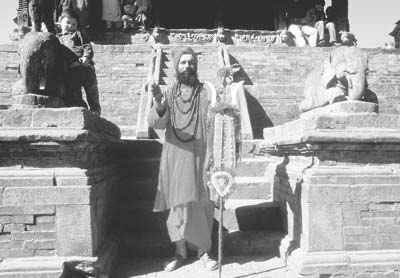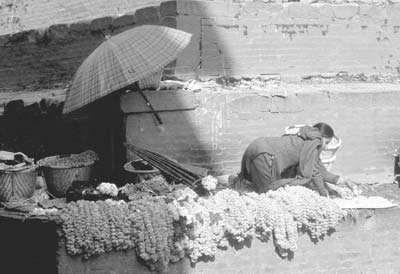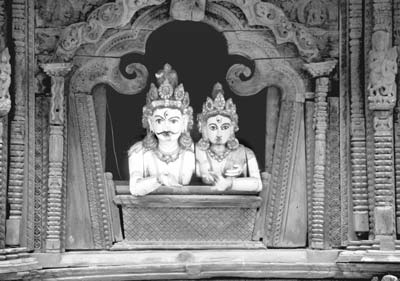Return to Kathmandu ... a Nepalese journey continues
by Steven Cole, Lowell, MI (Second of two parts, jump to part 1)
Flying into Kathmandu from Bangkok at the beginning of my trip three weeks earlier, I had my first glimpse of the mighty Himalayas and the Everest region from the seat of a Thai Airways 747. I’d been told to request a seat on the right side of the plane for the best view.
Roughly two hours into the 3-hour flight, there appeared on the horizon to the north what looked to be jagged teeth in a very long jawbone. Although the plane did not fly close enough to identify any of the mountains, I nevertheless got an idea of the immensity of the range, knowing that many of the peaks exceeded 20,000 feet. There seemed to be no end to them.
When the plane descended into the flat Kathmandu Valley, it was over hills that would be considered good-sized mountains in many nations.
Return to Kathmandu
It had been hazy in Kathmandu when I arrived from Bangkok, and it was just as hazy as I returned from Pokhara following my trek along the Annapurna Circuit. It is generally known that trekkers and climbers have polluted the Himalayas with trash over several decades, but it is less well known that the Kathmandu Valley is plagued by air pollution, which can obscure the mountains for days at a time.
As I entered the city my eyes smarted and my nostrils flared, assaulted by clouds of acrid smoke from vehicles fueled by leaded gas and seldom equipped with a functioning exhaust system. Many pedestrians and cyclists wore face masks.
Being winter, this was not the season to pursue my dream of hiking to Everest Base Camp. However, sightseeing flights to Everest on 20-seat prop planes operate year-round — haze permitting — and I optimistically booked a seat through a travel agent.
The cost of the flight on Buddha Air (www.buddhaair.com) had been recently raised from $75 to $120, which seemed pricey for 45 minutes in the air and only about 15 minutes in the Everest region, but, then again, there is only one Everest. Since flights are postponed until good flying weather, tickets do not have to be paid for until they are used.
For several days a pall hung over the city, and I was beginning to wonder if I’d ever see Everest up close. Then I learned that clear conditions were forecast for the next day. The following morning I arrived at the terminal at 7 for an 8:15 flight, but it was grounded for three hours until the smog lifted sufficiently. Then, suddenly, we were off.
Everest from the air
Airplane windows aren’t the best for viewing or photography, so Buddha Air lets passengers go into the cockpit one at a time for a view through the pilot’s windshield. Our pilot pointed out Everest and its famous neighbors, Lhotse and Nuptse, plus other peaks and a tiny airfield far below where climbers are dropped off to begin high-altitude expeditions.
The flight does not take you reach-out-and-touch-it close to the mountains, but the view is nonetheless awesome. I was thankful for having a zoom lens to isolate parts of the landscape. The pilot even leaned far forward so I could rest the camera on his back for a better shot.
All too soon the plane was headed back and the lone flight attendant passed out certificates testifying “I did not climb Mount Everest... but touched it with my heart.”
Area temples
After the mountains, the chief tourist attractions in Nepal are the scores of old Hindu temples concentrated mostly in Kathmandu Valley. Guidebooks imply that the temples are widely scattered in satellite towns. In fact, the towns are part of the contiguous urban sprawl and one center is no more than a relatively short taxi ride from another.
The most famous temple area, a UNESCO World Heritage Site, is Kathmandu’s Durbar Square, which actually consists of three smaller squares in the old part of the city where the country’s kings once lived. The oldest building is estimated to be from the 12th century, but most date from the 17th and 18th centuries.
The pagoda-like temples are covered with intricate carvings of Hindu gods and goddesses, human figures with animal heads and multiple arms, often depicted in sexual postures. There is also an extensive palace complex, dating from the 19th century, that includes a museum.
Almost as fascinating as the temples are the throngs of colorfully clad humanity at their bases selling souvenirs and produce or draped on the upper tiers smoking, chatting or sleeping.
The narrow streets around Durbar Square are crammed with tiny shrines, both Hindu and Buddhist, covered with years of wax from devotional candles and flanked by stalls selling everything from flashlight batteries to pungent dried fish. Pedestrians must compete with rickshaws, motorcycles, cars, mangy dogs and meandering sacred cows.
The three major temple sites in Kathmandu Valley charge visitors an entrance fee of approximately $1.50 to $3 per person. The temples are sometimes side by side with newer buildings, and the boundaries of the areas are not roped off or otherwise defined.
In Patan, near the zoo, is greater Kathmandu’s largest concentration of Tibetan rug dealers. But I found the selection limited and prices higher than in Hyangia near Pokhara.
Accommodations
In an attempt to find adequate, low-cost lodging in Kathmandu, I learned never to judge a Nepalese hotel by its lobby. The suburban Greenwich Village had a nice reception area and a pool, but the rooms were old, the furniture shabby and the plumbing erratic.
I switched to Kathmandu Guest House, located in the central tourist section of Thamel, which was recommended by a Nepali businessman. I was similarly disappointed.
I found Thamel far too crowded, dirty, noisy and, well, touristy, to suit me, so I sought to move on. I carried Lonely Planet’s “Nepal” and “Trekking in the Nepal Himalaya” as guides for hotels and other matters and often found information missing or inaccurate.
For example, Lonely Planet termed the Ambassador in the embassy area a “mid-range” hotel, but I was again fooled by an impressive lobby and found the rooms no better than those of budget hotels. I found the Manaslu, Everest and Gangjong hotels, also in the embassy area, to be almost up to American standards and priced at $35 to $40.
I settled on the Gangjong (P.O. Box 385, Lazimpat, Kathmandu; e-mail gangjong@mos.com.np) and talked the manager down to $30, as the off season and a Maoist scare had left the 5-story hotel with only one other guest. Many Nepalis do not practice a Western standard of cleanliness (a water cooler at the international airport had a communal drinking glass, for example), and I was glad to find that the Gangjong was carefully cleaned.
Food finds
I often took meals at the nearby Radisson ($140 for a single room), where a breakfast, lunch or dinner buffet of Western and Asian dishes cost only $8. Also nearby, and down an alley, I found a small Thai restaurant, Hym Thai, which had excellent satay for $3. And on the top floor of a rundown building on the corner of busy Lainchaur Avenue and the short unmarked street leading to the Radisson, I found a surprisingly well-appointed Chinese restaurant with excellent dinners priced from $4 to $7.
Near the embassy area is the huge, walled royal palace compound which covers at least a square mile. Over the wall I could see bamboos growing several stories high, the tallest I’d ever seen.
At a right angle to the compound on one side there was a broad avenue containing a few upscale shops and a Baskin-Robbins ice cream parlor — the only American restaurant presence I saw in Nepal — which I visited on my last day.
As I licked my ice cream cone, I reflected on my month-long stay. Nepal was not as storybook exotic and romantic as I had expected, but I found it highly interesting, safe (despite publicity to the contrary) and a true travel bargain.




